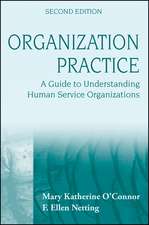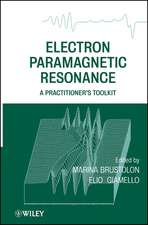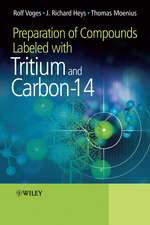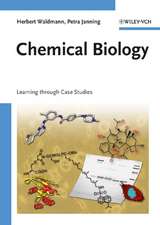Transport Processes and Separation Process Principles, Global Edition
Autor Christie Geankoplis, Christie John Geankoplisen Limba Engleză Paperback – 6 aug 2024
Thecompanion website (trine.edu/transport5ed/)contains additional homework problems that incorporate todays leadingsoftware, including Aspen/CHEMCAD, MATLAB, COMSOL, and Microsoft Excel.Instructors should visit the book's companion website periodically to obtainadditional homework problems.
Courses Transport Phenomena
Separation Processes
Preț: 525.58 lei
Preț vechi: 571.28 lei
-8% Nou
Puncte Express: 788
Preț estimativ în valută:
100.57€ • 109.59$ • 84.74£
100.57€ • 109.59$ • 84.74£
Carte disponibilă
Livrare economică 29 martie-04 aprilie
Livrare express 19-25 martie pentru 63.18 lei
Preluare comenzi: 021 569.72.76
Specificații
ISBN-13: 9781292445915
ISBN-10: 1292445912
Pagini: 1048
Dimensiuni: 210 x 270 x 35 mm
Greutate: 2.12 kg
Ediția:5. Auflage
Editura: Pearson
ISBN-10: 1292445912
Pagini: 1048
Dimensiuni: 210 x 270 x 35 mm
Greutate: 2.12 kg
Ediția:5. Auflage
Editura: Pearson
Cuprins
Part 1: Transport Processes: Momentum, Heat, and Mass
- Introduction to Engineering Principles and Units
- Chapter Objectives
- Classification of Transport Processes and Separation Processes (Unit Operations)
- SI System of Basic Units Used in This Text and Other Systems
- Methods of Expressing Temperatures and Compositions
- Gas Laws and Vapor Pressure
- Conservation of Mass and Material Balances
- Energy and Heat Units
- Conservation of Energy and Heat Balances
- Numerical Methods for Integration
- Chapter Summary
- Introduction to Fluids and Fluid Statics
- Chapter Objectives
- Introduction
- Fluid Statics
- Chapter Summary
- Fluid Properties and Fluid Flows
- Chapter Objectives
- Viscosity of Fluids
- Types of Fluid Flow and Reynolds Number
- Chapter Summary
- Overall Mass, Energy, and Momentum Balances
- Chapter Objectives
- Overall Mass Balance and Continuity Equation
- Overall Energy Balance
- Overall Momentum Balance
- Shell Momentum Balance and Velocity Profile in Laminar Flow
- Chapter Summary
- Incompressible and Compressible Flows in Pipes
- Chapter Objectives
- Design Equations for Laminar and Turbulent Flow in Pipes
- Compressible Flow of Gases
- Measuring the Flow of Fluids
- Chapter Summary
- Flows in Packed and Fluidized Beds
- Chapter Objectives
- Flow Past Immersed Objects
- Flow in Packed Beds
- Flow in Fluidized Beds
- Chapter Summary
- Pumps, Compressors, and Agitation Equipment
- Chapter Objectives
- Pumps and Gas-Moving Equipment
- Agitation, Mixing of Fluids, and Power Requirements
- Chapter Summary
- Differential Equations of Fluid Flow
- Chapter Objectives
- Differential Equations of Continuity
- Differential Equations of Momentum Transfer or Motion
- Use of Differential Equations of Continuity and Motion
- Chapter Summary
- Non-Newtonian Fluids
- Chapter Objectives
- Non-Newtonian Fluids
- Friction Losses for Non-Newtonian Fluids
- Velocity Profiles for Non-Newtonian Fluids
- Determination of Flow Properties of Non-Newtonian Fluids Using a Rotational Viscometer
- Power Requirements in Agitation and Mixing of Non-Newtonian Fluids
- Chapter Summary
- Potential Flow and Creeping Flow
- Chapter Objectives
- Other Methods for Solution of Differential Equations of Motion
- Stream Function
- Differential Equations of Motion for Ideal Fluids (Inviscid Flow)
- Potential Flow and Velocity Potential
- Differential Equations of Motion for Creeping Flow
- Chapter Summary
- Boundary-Layer and Turbulent Flow
- Chapter Objectives
- Boundary-Layer Flow
- Turbulent Flow
- Turbulent Boundary-Layer Analysis
- Chapter Summary
- Introduction to Heat Transfer
- Chapter Objectives
- Energy and Heat Units
- Conservation of Energy and Heat Balances
- Conduction and Thermal Conductivity
- Convection
- Radiation
- Heat Transfer with Multiple Mechanisms/Materials
- Chapter Summary
- Steady-State Conduction
- Chapter Objectives
- Conduction Heat Transfer
- Conduction Through Solids in Series or Parallel with Convection
- Conduction with Internal Heat Generation
- Steady-State Conduction in Two Dimensions Using Shape Factors
- Numerical Methods for Steady-State Conduction in Two Dimensions
- Chapter Summary
- Principles of Unsteady-State Heat Transfer
- Chapter Objectives
- Derivation of the Basic Equation
- Simplified Case for Systems with Negligible Internal Resistance
- Unsteady-State Heat Conduction in Various Geometries
- Numerical Finite-Difference Methods for Unsteady-State Conduction
- Chilling and Freezing of Food and Biological Materials
- Differential Equation of Energy Change
- Chapter Summary
- Introduction to Convection
- Chapter Objectives
- Introduction and Dimensional Analysis in Heat Transfer
- Boundary-Layer Flow and Turbulence in Heat Transfer
- Forced Convection Heat Transfer Inside Pipes
- Heat Transfer Outside Various Geometries in Forced Convection
- Natural Convection Heat Transfer
- Boiling and Condensation
- Heat Transfer of Non-Newtonian Fluids
- Special Heat-Transfer Coefficients
- Chapter Summary
- Heat Exchangers
- Chapter Objectives
- Types of Exchangers
- Log-Mean-Temperature-Difference Correction Factors
- Heat-Exchanger Effectiveness
- Fouling Factors and Typical Overall U Values
- Double-Pipe Heat Exchanger
- Chapter Summary
- Heat Exchangers
- Chapter Objectives
- Types of Exchangers
- Log-Mean-Temperature-Difference Correction Factors
- Heat-Exchanger Effectiveness
- Fouling Factors and Typical Overall U Values
- Double-Pipe Heat Exchanger
- Chapter Summary
- Introduction to Radiation Heat Transfer
- Chapter Objectives
- Introduction to Radiation Heat-Transfer Concepts
- Basic and Advanced Radiation Heat-Transfer Principles
- Chapter Summary
- Introduction to Mass Transfer
- Chapter Objectives
- Introduction to Mass Transfer and Diffusion
- Diffusion Coefficient
- Convective Mass Transfer
- Molecular Diffusion Plus Convection and Chemical Reaction
- Chapter Summary
- Steady-State Mass Transfer
- Chapter Objectives
- Molecular Diffusion in Gases
- Molecular Diffusion in Liquids
- Molecular Diffusion in Solids
- Diffusion of Gases in Porous Solids and Capillaries
- Diffusion in Biological Gels
- Special Cases of the General Diffusion Equation at Steady State
- Numerical Methods for Steady-State Molecular Diffusion in Two Dimensions
- Chapter Summary
- Unsteady-State Mass Transfer
- Chapter Objectives
- Unsteady-State Diffusion
- Unsteady-State Diffusion and Reaction in a Semi-Infinite Medium
- Numerical Methods for Unsteady-State Molecular Diffusion
- Chapter Summary
- Convective Mass Transfer
- Chapter Objectives
- Convective Mass Transfer
- Dimensional Analysis in Mass Transfer
- Mass-Transfer Coefficients for Various Geometries
- Mass Transfer to Suspensions of Small Particles
- Models for Mass-Transfer Coefficients
- Chapter Summary
- Absorption and Stripping
- Chapter Objectives
- Equilibrium and Mass Transfer Between Phases
- Introduction to Absorption
- Pressure Drop and Flooding in Packed Towers
- Design of Plate Absorption Towers
- Design of Packed Towers for Absorption
- Efficiency of Random-Packed and Structured Packed Towers
- Absorption of Concentrated Mixtures in Packed Towers
- Estimation of Mass-Transfer Coefficients for Packed Towers
- Heat Effects and Temperature Variations in Absorption
- Chapter Summary
- Humidification Processes
- Chapter Objectives
- Vapor Pressure of Water and Humidity
- Introduction and Types of Equipment for Humidification
- Theory and Calculations for Cooling-Water Towers
- Chapter Summary
- Filtration and Membrane Separation Processes (LiquidLiquid or SolidLiquid Phase)
- Chapter Objectives
- Introduction to Dead-End Filtration
- Basic Theory of Filtration
- Membrane Separations
- Microfiltration Membrane Processes
- Ultrafiltration Membrane Processes
- Reverse-Osmosis Membrane Processes
- Dialysis
- Chapter Summary
- Gaseous Membrane Systems
- Chapter Objectives
- Gas Permeation
- Complete-Mixing Model for Gas Separation by Membranes
- Complete-Mixing Model for Multicomponent Mixtures
- Cross-Flow Model for Gas Separation by Membranes
- Derivation of Equations for Countercurrent and Cocurrent Flow for Gas Separation by Membranes
- Derivation of Finite-Difference Numerical Method for Asymmetric Membranes
- Chapter Summary
- Distillation
- Chapter Objectives
- Equilibrium Relations Between Phases
- Single and Multiple Equilibrium Contact Stages
- Simple Distillation Methods
- Binary Distillation with Reflux Using the McCabeThiele and Lewis Methods
- Tray Efficiencies
- Flooding Velocity and Diameter of Tray Towers Plus Simple Calculations for Reboiler and Condenser Duties
- Fractional Distillation Using the EnthalpyConcentration Method
- Distillation of Multicomponent Mixtures
- Chapter Summary
- LiquidLiquid Extraction
- Chapter Objectives
- Introduction to LiquidLiquid Extraction
- Single-Stage Equilibrium Extraction
- Types of Equipment and Design for LiquidLiquid Extraction
- Continuous Multistage Countercurrent Extraction
- Chapter Summary
- Adsorption and Ion Exchange
- Chapter Objectives
- Introduction to Adsorption Processes
- Batch Adsorption
- Design of Fixed-Bed Adsorption Columns
- Ion-Exchange Processes
- Chapter Summary
- Crystallization and Particle Size Reduction
- Chapter Objectives
- Introduction to Crystallization
- Crystallization Theory
- Mechanical Size Reduction
- Chapter Summary
- Settling, Sedimentation, and Centrifugation
- Chapter Objectives
- Settling and Sedimentation in ParticleFluid Separation
- Centrifugal Separation Processes
- Chapter Summary
- Leaching
- Chapter Objectives
- Introduction and Equipment for LiquidSolid Leaching
- Equilibrium Relations and Single-Stage Leaching
- Countercurrent Multistage Leaching
- Chapter Summary
- Evaporation
- Chapter Objectives
- Introduction
- Types of Evaporation Equipment and Operation Methods
- Overall Heat-Transfer Coefficients in Evaporators
- Calculation Methods for Single-Effect Evaporators
- Calculation Methods for Multiple-Effect Evaporators
- Condensers for Evaporators
- Evaporation of Biological Materials
- Evaporation Using Vapor Recompression
- Chapter Summary
- Drying
- Chapter Objectives
- Introduction and Methods of Drying
- Equipment for Drying
- Vapor Pressure of Water and Humidity
- Equilibrium Moisture Content of Materials
- Rate-of-Drying Curves
- Calculation Methods for a Constant-Rate Drying Period
- Calculation Methods for the Falling-Rate Drying Period
- Combined Convection, Radiation, and Conduction Heat Transfer in the Constant-Rate Period
- Drying in the Falling-Rate Period by Diffusion and Capillary Flow
- Equations for Various Types of Dryers
- Freeze-Drying of Biological Materials
- Unsteady-State Thermal Processing and Sterilization of Biological Materials
- Chapter Summary
- Appendix A.1 Fundamental Constants and Conversion Factors
- Appendix A.2 Physical Properties of Water
- Appendix A.3 Physical Properties of Inorganic and Organic Compounds
- Appendix A.4 Physical Properties of Foods and Biological Materials
- Appendix A.5 Properties of Pipes, Tubes, and Screens
- Appendix A.6 Lennard-Jones Potentials as Determined from Viscosity Data
- Notation
- Index






